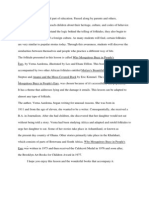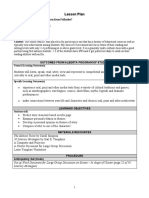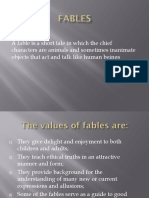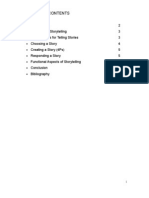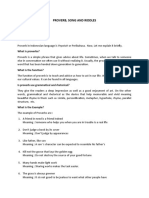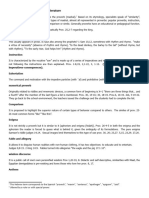Lesson Plan For Conference
Uploaded by
mduffy24Lesson Plan For Conference
Uploaded by
mduffy24Fabulous Filipino Folklore
Class description: Adults/teachers
Context and content: Audience has no prior knowledge of Filipino folklore. I want them
to get a taste of what it is and how it can be integrated in to the English classroom. Two
areas students have difficulty in are dialogue and creative writing. Assume that teachers
have already spent time explaining these two processes and Filipino folklore is a
supplement to these unit plans.
Objectives:
Recognize genres: legends/myths, proverbs, riddles, and folktales.
Recognize themes of folk literature.
Create dialogue based on myths.
Creative writing of own myth.
Materials needed: pens, markers (1 per group), poster board (one per group), 1 copy of
myths (the stories) and 1 copy of major themes (explanation) from
www.seasite.niu.edu/tagalog , Twelve stamps book, 2 bags and slips of paper for “Whose
Folktale is it Anyway?” activity, proverbs handout (one per person), copies on disk of
today’s presentation (one per person), overheads of “overview” “two questions”
“themes” “Palay story,”
Activities and procedures:
Pre-activity (2 minutes):
Introduce self
Place “overview” on overhead projector.
Answer two questions
Question 1: Emphasize the size of this minority group so they get an idea of how
big the group actually is; need to incorporate more culture into the multicultural
classroom.
Question 2: The projected increase is huge, even in the next 20 years.
There are 4 main genres of Filipino folklore. They are: Proverbs, Riddles, Folktales, and
Legends/Myths. I’m going to try to get somewhat in depth about the legends/myths, but
we will go over a few quick examples of the others first.
Activity #1 (5-10 minutes): Pass around Proverbs handout as you speak: .One way to
unify our cultures in the classroom is to show how we think alike. I am passing out a list
of Proverbs from the Philippines. I want you to look at them and find an English-
equivalent adage. We will not be able to find similarities for all of the proverbs, but if
you can think of one, please shout out the number so we can all look at it and then you
tell us the adage you think is closest to its meaning.
Some of our stories are the same as well:
Twelve Stories for Twelve Stamps anthology—Deer and Snail, Hermit Crab and
Turtle compared to Tortoise and Hare.
Activity #2 (5 minutes): Another genre of Filipino Folklore is Riddles. Riddles are used
to describe customs, thoughts, everyday life, and the native environment of the Filipinos.
Answering riddles is a native game of the mind common in the Philippines.
An example of an American riddle is:
What has a face and two hands but no mouth? A clock
An example of a Filipino riddle is:
What is overflowing with tears but without eyes/walking smoothly but without feet? A
ballpoint pen.
What is made of bone and skin and goes up flying? A kite
What is taller when sitting and shorter when standing? A dog
Activity #3 (5 minutes): The third genre is Folktales, which are signs or omens. These
are best likened to superstitious beliefs and like America, not everyone believes them.
They are not just about luck, but cover many different areas of life such as:
Wealth: A white butterfly is a sign of impending wealth.
Love: Engaged couples should not exchange pointed or sharp objects as
gifts, or this would lead to a broken engagement.
Animals: A cat wiping its face is a sign that a visitor is coming.)
Eating: If you choke briefly at mealtime, someone far away remembers you, or is talking
about you. To find out who that person could be, immediately ask for any number from
the people who are eating with you. The number that will match a letter in the alphabet
will be the first letter of the person's name who knows you and is the one who might have
remembered you.
Illness or Death: Going to bed with wet hair leads to blindness and insanity.
Activity #4 (10-15 minutes): The fourth and last genre is Myths(Legends):
I’m passing out an explanation of the main themes in Filipino folklore.
“A myth is a sacred narrative explaining how the world and man came to be in their
present form” (Dundes)(see mga alamat themes explained for cite). Assigning
supernatural origins to natural occurrences are a facet of understanding one’s culture.
Ask if they can name any such as Johnny Appleseed or Paul Bunyan and Babe. We will
take turns reading them aloud. I will show each theme on the overhead and whoever has
that explanation should read it aloud.
Next, I’m going to read the story of Palay—A story about the most importance food
source in the Philippines--rice.
Transition into English classroom—how do we practice English skill building with
stories like this? Remember that these stories were passed down orally, so let’s construct
dialogue. Now that we know the main themes, it’s time to read a couple of stories.
Activity #5 (15 minutes): Get into groups of two or three and choose a story from the
copies that I have. Your group will form a dialogue and present it to the rest of the
participants.
Now that you’re comfortable with the themes and what folktales sound like, we’re going
to play a creative writing game called “Whose Folktale is it Anyway?”
Activity #6 (15-20 minutes). Remember those slips of paper you filled out earlier? Now
they are writing prompts for you to write a folktale around. You can do this by yourself
or in a group—doesn’t matter. I have poster board and markers so that you or your group
can present your folktale to everyone else. They can be as silly or serious as you like.
Extension ideas:
Costuming
Scene blocking
You might also like
- Spanish Short Stories For Beginners 2nd Edition Charles Mendel - The ebook is ready for download to explore the complete content100% (2)Spanish Short Stories For Beginners 2nd Edition Charles Mendel - The ebook is ready for download to explore the complete content63 pages
- 21st Century Literature - Unit 5 - Lesson 3 - Philippine Mythology and Philippine Folk Lyric and SpeechNo ratings yet21st Century Literature - Unit 5 - Lesson 3 - Philippine Mythology and Philippine Folk Lyric and Speech24 pages
- Spanish Short Stories For Beginners 2nd Edition Charles Mendel download pdf100% (1)Spanish Short Stories For Beginners 2nd Edition Charles Mendel download pdf55 pages
- Download Full (Ebook) Spanish Short Stories For Beginners by Charles Mendel ISBN 9781985641402, 1985641402 PDF All Chapters100% (8)Download Full (Ebook) Spanish Short Stories For Beginners by Charles Mendel ISBN 9781985641402, 1985641402 PDF All Chapters65 pages
- CLP - 1stQ - Module 1_PDF_27832d4734ae445778993383319a8f3dNo ratings yetCLP - 1stQ - Module 1_PDF_27832d4734ae445778993383319a8f3d8 pages
- Seminar 3 Psycholinguistics Practical Part 1. Study The Hypotheses Below and Carry Out ExperimentsNo ratings yetSeminar 3 Psycholinguistics Practical Part 1. Study The Hypotheses Below and Carry Out Experiments3 pages
- Lesson Plan: General Learning Outcome(s)No ratings yetLesson Plan: General Learning Outcome(s)6 pages
- Teaching Reading Methodologies PowerpointNo ratings yetTeaching Reading Methodologies Powerpoint21 pages
- Media-Based Arts and Design in The PhilippinesNo ratings yetMedia-Based Arts and Design in The Philippines29 pages
- Activities For Birth To Preschool: The Early Years: Activity 1: Books and BabiesNo ratings yetActivities For Birth To Preschool: The Early Years: Activity 1: Books and Babies15 pages
- Philippine Literature During Pre-Colonial PeriodNo ratings yetPhilippine Literature During Pre-Colonial Period20 pages
- Wild About Group Time: Simple Literacy Plans for PreschoolFrom EverandWild About Group Time: Simple Literacy Plans for PreschoolNo ratings yet
- 575998173-Bless-Me-Ultima-Complete-Study-PacketNo ratings yet575998173-Bless-Me-Ultima-Complete-Study-Packet30 pages
- Charles Mendel Spanish Short Stories For BeginnersNo ratings yetCharles Mendel Spanish Short Stories For Beginners79 pages
- 21st Century Literature From The Philippines and The WorldNo ratings yet21st Century Literature From The Philippines and The World84 pages
- 614ea3dfc971c Puposive Communication Module 5 and 6No ratings yet614ea3dfc971c Puposive Communication Module 5 and 67 pages
- Lesson 1: Survey in The Philippine HistoryNo ratings yetLesson 1: Survey in The Philippine History7 pages
- Coyote Still Going: Native American Legends and Contemporary StoriesFrom EverandCoyote Still Going: Native American Legends and Contemporary StoriesNo ratings yet
- 21 Century Literature From The Philippines and The WorldNo ratings yet21 Century Literature From The Philippines and The World15 pages
- Charactersketch3turn Inpost FlorencesicesNo ratings yetCharactersketch3turn Inpost Florencesices2 pages
- Antony Rowland - Metamodernism and Contemporary British Poetry-Cambridge University Press (2021)100% (1)Antony Rowland - Metamodernism and Contemporary British Poetry-Cambridge University Press (2021)254 pages
- My Pals Are Here! English 1A Lesson Plans Unit 6 - Jobs People DoNo ratings yetMy Pals Are Here! English 1A Lesson Plans Unit 6 - Jobs People Do16 pages
- Module 2 LESSON 21st Century LiteratureNo ratings yetModule 2 LESSON 21st Century Literature17 pages
- Literature in Pre-Colonial Period: Dao Catholic High School, IncNo ratings yetLiterature in Pre-Colonial Period: Dao Catholic High School, Inc6 pages
- 35 Mathematical Riddles with Answers - GeeksforGeeks 2No ratings yet35 Mathematical Riddles with Answers - GeeksforGeeks 21 page
- Usr Local SRC Education - Com Files Static Lesson-Plans Decimal-Fractions-Number-Line-Riddles Decimal-Fractions-Number-Line-RiddlesNo ratings yetUsr Local SRC Education - Com Files Static Lesson-Plans Decimal-Fractions-Number-Line-Riddles Decimal-Fractions-Number-Line-Riddles4 pages
- Philippine Pre Colonial Literature StudentNo ratings yetPhilippine Pre Colonial Literature Student31 pages
- پروليون،ڏٺون،معمائون ۽ ٻول-نبي بخش بلوچ-1983-صاف100% (1)پروليون،ڏٺون،معمائون ۽ ٻول-نبي بخش بلوچ-1983-صاف322 pages





